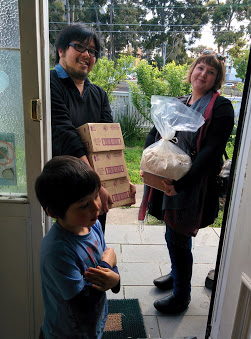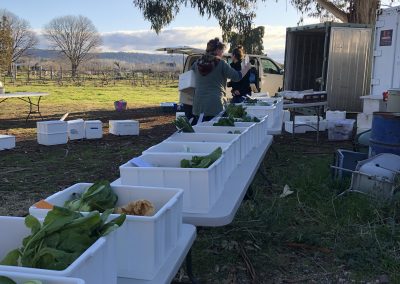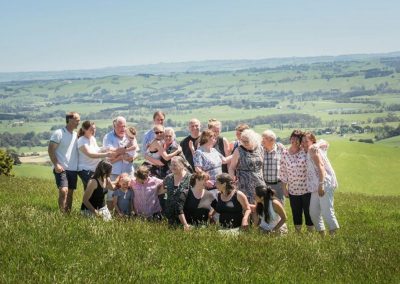Case Study
Westies Dry Goods Buying Group
Background
Westies Buying Group is an informal, not for profit community group which utilises collective purchasing power to attain bulk dry goods at wholesale prices. The buying group makes organic products affordable for members, in an area of Melbourne where there are few organic retailers. The group also has a strong emphasis on reducing food packaging as members are required to supply reusable containers to pack their orders into. In addition to the monthly dry goods ordering, the group also has a thriving Facebook group where members can connect with likeminded people, share skills and explore ideas around sustainable living.
The buying group identifies the following core values:
- Making organic food affordable
- Reducing food packaging
- Supporting and promoting sustainable farmers and their produce
- Reducing food waste
- Skills sharing and produce sharing on the facebook community
The Journey
Westies was started in 2013 by a group of 8-9 families who got together to order food in bulk so they could enjoy better prices for the products they loved. The group had a preference for organic food but found that at retail prices it was outside their budget. Initially the Westie’s product range was quite limited, including basics like eggs and milk. After some time it was suggested that the group should grow their membership so they could order a broader variety of goods in wholesale quantities. As more people got on board, the admin tasks of processing orders and procuring the stock became significantly more work, so they group started to charge a 15% admin fee to members, which is paid to Kemmy, a member who takes responsibility for administering the group.
Operations
Ordering and distribution
Today, ordering takes place once each month. Members have a window of time to place their order in Westie’s online shopfront, which is hosted on the Open Food Network. Members who have placed orders are asked to drop off their containers at Kemmy’s house ready for packing. When the order cycle closes, Kemmy sorts, weighs and packs the orders in her dining room. Then, when orders have been packed, Kemmy will put a post on Facebook telling members that they can collect their orders. Collection is from Kemmy’s house, where she leaves the orders on the porch. So far there has been no food stolen. Some members have organised secondary pick up points with other members who live close to each other, taking it in turns to collect the orders from Kemmy’s house. The whole packing and collection process usually takes about a week after the ordering deadline. Payment is then expected within 2 weeks, via bank transfer.

Staff/volunteers
The administration tasks of this group are completed almost solely by Kemmy, one of the group’s founders. The 15% admin fee paid by customers reimburses Kemmy for her time. Kemmy found that coordinating tasks with volunteers could be more work than completing the tasks herself. Without volunteers, Kemmy can collect the stock from suppliers when it’s convenient for her and also sort the stock at her house when she has a moment. Experience has shown that it can be unrealistic to expect infrequent volunteers to get a handle of the administration processes and to perform them more efficiently than one person who knows the processes well. The group’s members are generally happy to have a hands off approach to the buying group’s operations, and those who want to get more involved can do so via events and conversations on the facebook group.
Products and Suppliers
Westies regularly offers a large range of dry goods, dairy and cleaning products. In total the average monthly order cycle will have around 300 products available for order. Occasionally when excess produce becomes available from producers, members, or platforms like Yume, it is also traded through Westie’s facebook page. The group’s approach to selecting products is to prioritise organic or spray free items first, and secondly to select those which are Australian grown over imported. When Kemmy has received all of the orders she will see which items reached the bulk wholesale quantity, and place these orders with the suppliers. For products which had low quantities ordered, Kemmy will either not order them, or if they have a long shelf life and are likely to sell next month, she will order them and hold any leftover stock. The group has a total of seven suppliers; four dry goods wholesalers, one manufacturer, and two producers. Three of the suppliers deliver and Kemmy collects the stock from the other suppliers.

Using the OFN
Initially the group used Google spreadsheets to administer the orders. Each member could login and mark off the items they wished to order, however it was a confusing process as they needed to navigate multiple sheets containing each supplier’s product range. There was always a risk that someone would accidently change formulas within the sheet, or alter the prices, so Kemmy had to maintain multiple copies of the spreadsheets, which was time consuming and difficult to administer.
Using the OFN for ordering and the buying group’s administration has been a great improvement from their original spreadsheet based system. Members find it easier to order through the shopfront, and it removes the need to explain a complex system to new members. Kemmy’s favourite tools on the OFN are the reports. She uses the Order Cycle Totals reports to figure out what quantities of each product to order from suppliers. She also uses the packing report to guide her packing process, and the payment report to see which customers have outstanding invoices to pay. Finally the bulk order management tool comes in handy when she needs to edit orders.
Managing the size of the group
The size and ordering schedule of Westies has evolved over time. From the initial inception as a group of a dozen friends, the group grew in size significantly after three local food coops decided to ‘outsource’ their dry goods operations to Westies. This was a real turning point for the group, as it gave them momentum and stability in numbers. However, subsequently Kemmy found that her house, which operated as the stock room, was getting overfilled with products and containers. To address this she needed to split the group into two, with each group having a maximum of 30 people, ordering every 3 months. Kemmy has since moved into a larger house, and has more space to store the stock and to perform the packing. The group can now accommodate 120 members and provides monthly ordering. On an average month approximately 25-30 members will place orders.
Managing the group’s size is important to how effectively and efficiently the buying group can operate. Kemmy found that when the group was small and ordering infrequently, the group fell short of the bulk buy threshold for less popular items, meaning members didn’t get as much product variety. Increasing member numbers and the frequency of ordering means that the group reaches the bulk order quantity for a broader range of products, so customer are happy and Kemmy doesn’t have to worry about having excess stock remaining. Now, when there is extra stock left over, it can be quickly promoted and moved, via the facebook group.
While growing the group has benefits, it was important to restrict the group’s size, not only because of limitations around Kemmy’s capacity and the space she has available, but also to maintain the integrity of this model, which emphasises fostering local connections and social capital. Kemmy believes that keeping the membership small and growing it by referals only, is also vital for accountability. Westies’ customers often receive their goods in advance of paying, so it’s important that they are trustworthy and emotionally and socially invested in the buying group’s wellbeing. Limiting the sizes of group means that Westies has a long waiting list, which is testament to the group’s positive reputation in the community.

Customers
Recruiting members hasn’t been a problem for Westies, and they haven’t conducted any marketing activities beyond their facebook group. Strong word of mouth means that the group has plenty of sign ups. Many of the members are loyal long term customers and Kemmy puts this down to the affordability of the products. One customer said that her overall food spend had reduced by 30% since becoming a member. This element is a particularly strong draw card in the inner west of Melbourne, where there are few affordable organic dry goods outlets.
Shopping with minimal packaging is also hard to pass up for customers who are environmentally minded. One customer remarked that the group had encouraged her family to move away from packaged food, because their pantry was suddenly full of wholefoods which they soon learned how to use to make everything they needed. Another member was pleased to see her children learning the different between ‘food like substances’ which come in packages, and real food. This waste minimising mindset also extends to food waste, and members commonly share their tips for how to reduce waste in the home.
Further, members often acknowledge that the social opportunities and feelings of inclusion are another one of the primary appeals of the group. The membership are likeminded people who can bond and connect over their shared values of sustainability and supporting fairer, healthier food systems. It’s common for members to mingle and share recipes and baked goods when they collect their orders. One member enjoyed the activity of cooperating with others on pickup days, but interestingly she suspects that this feeling of relying on others and committing to the group could be a turn off for people who have never been part of a coop or buying group before. Members who find that Westie’s approach to buying food doesn’t fit in with their lifestyle will drop off, so overall the members who stick around are accepting of the convenience trade off that comes with shopping through a buying group and embrace it.

The Facebook group
Shortly after the group expanded a Facebook group was created as a place where members could communicate and share ideas. The page also came to function as place for trading outside of the regular buying group schedule. The Facebook group is a testament to how engaged the network of members is. The page sees plenty of dialogue and connections form between members, through skill sharing, or advertising events of common interest. There’s an unspoken rule that any cultures or starters for fermenting various things are not to be sold on the facebook page, but should instead be shared freely amongst members, to encourage social interaction between members.
The Future
Westies doesn’t currently have any plans to change their operations in the future. They recognise that there is demand for organic food in their area beyond what Westies can cater to. Kemmy would love to see more food hubs and buying groups start up in the west of Melbourne, but sees that time and getting the startup finance pose significant barriers to this.

Other Open Food Network Case Studies
Can we help?
Have an idea, a project or a question? Want help using the Open Food Network software? Get in touch and find out how we can help you with it.
Keep in touch
Join us
Create a listing, shop or group directory on the Open Food Network. Tell me more!

Read our Terms and conditions | Find us on GitHub
Open Food Network is a free and open source software platform. Our content is licensed with CC BY-SA 3.0 and our code with AGPL 3.
We take good care of your data. See our cookies policy




